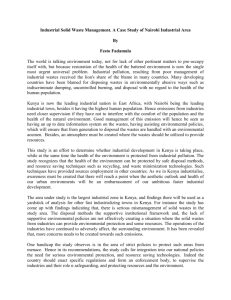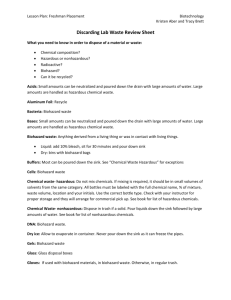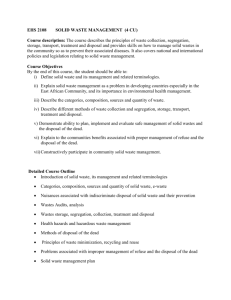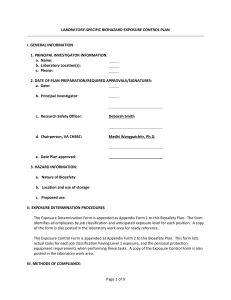Department of Physiology Safety & Health
advertisement
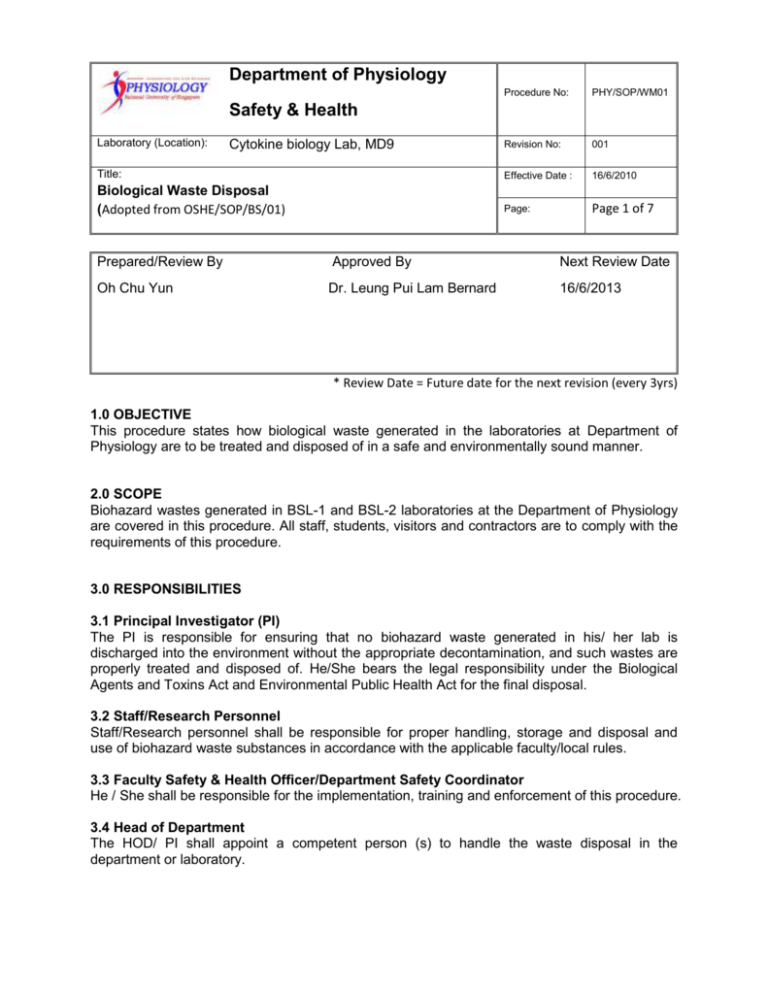
Department of Physiology Procedure No: PHY/SOP/WM01 Revision No: 001 Title: Effective Date : 16/6/2010 Biological Waste Disposal (Adopted from OSHE/SOP/BS/01) Page: Page 1 of 7 Safety & Health Laboratory (Location): Cytokine biology Lab, MD9 Prepared/Review By Approved By Next Review Date Oh Chu Yun Dr. Leung Pui Lam Bernard 16/6/2013 * Review Date = Future date for the next revision (every 3yrs) 1.0 OBJECTIVE This procedure states how biological waste generated in the laboratories at Department of Physiology are to be treated and disposed of in a safe and environmentally sound manner. 2.0 SCOPE Biohazard wastes generated in BSL-1 and BSL-2 laboratories at the Department of Physiology are covered in this procedure. All staff, students, visitors and contractors are to comply with the requirements of this procedure. 3.0 RESPONSIBILITIES 3.1 Principal Investigator (PI) The PI is responsible for ensuring that no biohazard waste generated in his/ her lab is discharged into the environment without the appropriate decontamination, and such wastes are properly treated and disposed of. He/She bears the legal responsibility under the Biological Agents and Toxins Act and Environmental Public Health Act for the final disposal. 3.2 Staff/Research Personnel Staff/Research personnel shall be responsible for proper handling, storage and disposal and use of biohazard waste substances in accordance with the applicable faculty/local rules. 3.3 Faculty Safety & Health Officer/Department Safety Coordinator He / She shall be responsible for the implementation, training and enforcement of this procedure. 3.4 Head of Department The HOD/ PI shall appoint a competent person (s) to handle the waste disposal in the department or laboratory. Department of Physiology Procedure No: PHY/SOP/WM01 Revision No: 001 Title: Effective Date : 16/6/2010 Biological Waste Disposal (Adopted from OSHE/SOP/BS/01) Page: Page 2 of 7 Safety & Health Laboratory (Location): Cytokine biology Lab, MD9 4.0 DEFINITION Infectious waste, pathological waste, bio-contaminated sharps and other bio-contaminated waste from treatment areas are considered as biohazard wastes which need special handling and disposal. Infectious wastes need pre-treatment before they are disposed of as biohazard waste. a. Waste: Materials which no longer can be used for the purpose they were intended for originally b. Biohazard Waste: Wastes which by their nature and quality may be potentially detrimental to human health and/or the environment. c. OSHE: Office of Safety, Health and Environment (NUS) d. Competent Person: A person who has undergone appropriate training course approved by the university 5.0 PROCEDURES Wastes from laboratories may include infectious wastes, pathological wastes, contaminated sharps, routine clinical wastes, cytotoxic wastes, radioactive wastes, pharmaceutical wastes, chemical wastes and general wastes. Wastewater generated from biological/ food analysis labs can be discharged directly into the sewer after dilution. 5.1 Biohazard waste classification a. Biohazard wastes shall be classified based on their treatment or disposal methods (refer to Appendix 1). b. Faculty Safety & Health Officer or the Office of Safety, Health and Environment (OSHE) shall assist the Principal Investigator in determining waste and hazard classification if required. c. The waste container/bottle shall have caution labels indicating the hazard classification of waste. d. Except for sharps and liquid wastes for disposal into sewer, all biohazard wastes are to be placed in yellow plastic bag with biohazard sign printed on it. Sharps shall be placed in appropriate sharps containers. e. If the biohazard waste is contaminated with chemical agents, the waste is to be treated as chemical waste. The biohazard component of the waste shall be inactivated by compatible chemical disinfectants prior to its release for chemical disposal. In general autoclaving is not recommended for chemical wastes. Under heat and pressure some chemicals may explode or there could be release of toxic chemicals during the autoclaving process. f. If the biohazard waste is contaminated with radioactive waste, the biohazard component of the waste shall be inactivated prior to disposal as radioactive waste. If the biohazard component cannot be inactivated, the mixed waste must be stored in a freezer at -20 Department of Physiology Procedure No: PHY/SOP/WM01 Revision No: 001 Title: Effective Date : 16/6/2010 Biological Waste Disposal (Adopted from OSHE/SOP/BS/01) Page: Page 3 of 7 Safety & Health Laboratory (Location): Cytokine biology Lab, MD9 degree with appropriate radioactive shielding until the radioactivity has decayed to a level below the limit of 1mRem/hr (1 μSv/hr). 5.2 Biohazard waste disposal a. All wastes containing biohazard material should be handled with gloves. b. All general wastes which are non-biohazard and are not classified as chemical, radioactive or other wastes, must be segregated from the biohazard waste stream whenever possible. a. For example, paper and plastic items such as wrappers which are not contaminated should be disposed of in the general waste stream. b. Contaminated lab coats, dirty gloves and other contaminated materials must be autoclaved as a first priority. If an autoclave is not available, then disposal of biohazard wastes through incineration should be arranged with a NEA licensed biohazard wastes contractor. To assure adequacy of sterilization, autoclaves must be tested routinely with spore strips and other methods as recommended by the manufacturer. Refer to OSHE’s Guidelines on Operation of Autoclaves (CBL/SOP/05). c. Free flowing liquid biohazard wastes (e.g. cultures of microorganisms, tissue culture wastes, etc.) shall not be disposed of with solid waste nor discarded down the drainage system without prior treatment. The waste shall be contained in leak proof, rigid durable containers labeled with the biohazard symbol and the word “biohazard”. Liquid wastes shall be decontaminated by autoclaving or with the use of an appropriate chemical disinfectant in accordance with the manufacturer’s recommendations. The treated waste can then be disposed in the sewer system if the chemical disinfectant is not prohibited from discharge into the sewer. d. Sharps shall be placed in appropriate yellow sharps containers that are labeled “biohazard”. Sharps must not be placed in the yellow biohazard waste bags. 5.3 Sharp-waste disposal a. Sharps pose a physical-injury hazard as well as an infection hazard and a high degree of precaution should be taken. These include blood-drawing equipment, needles, syringes, slides, Pasteur pipettes, capillary tubes, broken glass and scalpel blades. b. Biologically contaminated sharps wastes are to be handled separately and differently from the ordinary trash. All contaminated sharps are to be treated as infectious and disposed of only through licensed biohazard waste collectors. c. Contaminated needles should not be broken or clipped. Needles shall not be recapped or separated from syringes prior to disposal. Department of Physiology Procedure No: PHY/SOP/WM01 Revision No: 001 Title: Effective Date : 16/6/2010 Biological Waste Disposal (Adopted from OSHE/SOP/BS/01) Page: Page 4 of 7 Safety & Health Laboratory (Location): Cytokine biology Lab, MD9 d. Containers for sharps (sharps disposal containers) should be impervious, rigid and puncture proof. Sharps containers shall not be filled beyond the recommended fill line, which is usually at the ¾ mark of the container. e. Sharps containers shall remain closed at all times except when sharps are being deposited into the container. Sharps containers shall not be placed on the floor in the lab at all times. f. Filled sharps containers should be sealed once they reach the ¾ full mark, labeled as ‘SHARPS’ and the biohazard symbol before disposal by licensed biohazard waste collectors. 5.4 Autoclavable Material a. All laboratory specimens or materials consisting of, containing, or contaminated with blood, plasma, serum, urine, fasces or other human or animal tissues or fluids, as well as inoculated media, cultures, and other potentially infectious materials, must be sterilized by autoclaving. Refer to OSHE’s Guidelines on Operation of Autoclaves (OSHE/SOP/BS/03). If autoclaving is not possible, the waste is to be sent to NEAlicensed biohazard waste collectors for incineration. b. Contaminated solid wastes such as cloth, plastic and paper items (e.g. wrappers and paper towels) must be put into biohazard bags and autoclaved. c. After verification of successful autoclaving, the waste is no longer considered biohazard and can be disposed of as general waste. For solid wastes, place yellow biohazard bags inside black trash bags before placing in the general waste. Refer to Guidelines on Operation of Autoclaves (CBL/SOP/05). Autoclaved liquid wastes can be discharged into the sewer with copious amounts of water. d. Dry hypochlorite or other strong oxidizers should not be autoclaved with organics such as paper and oil. This may lead to explosion. 5.5 Wastes for Incineration a. Animal carcasses, recognizable human anatomical remains, organs or large tissues and sharps wastes are to be disposed of via licensed biohazard waste collectors for incineration. b. Animal carcasses, including those intentionally infected with biological agents, should be sealed in double yellow biohazard bags and stored in a freezer prior to collection by the biohazard waste collectors. 5.6 Chemically decontaminated wastes a. Wastes which cannot be autoclaved should be chemically decontaminated. b. Swabs and other disposables soaked in a disinfectant may be double-bagged and treated routinely as general garbage. When using a disinfectant, precautions should be taken in accordance with the MSDS to prevent splashing and other harmful exposure. Department of Physiology Procedure No: PHY/SOP/WM01 Revision No: 001 Title: Effective Date : 16/6/2010 Biological Waste Disposal (Adopted from OSHE/SOP/BS/01) Page: Page 5 of 7 Safety & Health Laboratory (Location): Cytokine biology Lab, MD9 c. Chemically decontaminated wastes should be disposed through licensed toxic industrial waste collectors if the chemicals found in the waste pose a hazard to handlers or are prohibited from discharge into the sewer. 5.7 Non infectious and environmentally benign wastes a. When there is no reasonable evidence to indicate that clinical specimen or other materials may contain an infectious agent and is otherwise environmentally benign, disposal into the general waste stream without sterilization is allowed. b. Materials that can be directly discarded into the sewer include un-inoculated liquid mediums, tissue culture, nutrient fluids, serum and plasma or blood provided these specimens have been chemically decontaminated and the chemical is not prohibited from discharge into the sewer. 5.8 Storage and transport a. All biohazard waste containers should be properly sealed and marked with the biohazard label. Yellow biohazard waste bags should be secondarily contained whenever deemed necessary. The Principal Investigator or his designate shall ensure that all wastes are segregated and stored at the designated storage areas. Waste Storage Locations are to be confirmed with the Department and should be properly labeled as a biohazard waste storage area. The PI and staff shall ensure good housekeeping for all biohazard wastes stored in the common area under their jurisdiction. b. Prior to entering into or renewing any contract with a waste collector, a Competent Person, or a. Faculty Safety & Health Officer shall ensure that the waste collector has a valid license for the type of waste to be collected from NUS. The Competent Person with the assistance of Faculty b. Safety & Health Officer (if required with the assistance of OSHE) shall arrange for licensed biohazard waste collectors / toxic industrial waste (TIW) collectors to collect the hazardous waste when necessary. c. A consignment note shall be completed for all hazardous wastes and TIW collected. Consignment notes for TIW shall be submitted to NEA’s Pollution Control Department (PCD) through e-tracking or mail. d. Transport approval from PCD is required for consignment of TIW exceeding the prescribed quantity under Environmental Public Health (TIW) Regulations. e. Transport of biohazard wastes outside of the laboratory (e.g. to an autoclave facility or collection point) should be done in a closed, leak-proof secondary container labeled “biohazard”. Department of Physiology Procedure No: PHY/SOP/WM01 Revision No: 001 Title: Effective Date : 16/6/2010 Biological Waste Disposal (Adopted from OSHE/SOP/BS/01) Page: Page 6 of 7 Safety & Health Laboratory (Location): Cytokine biology Lab, MD9 6 RECORDS PI or his/her designate shall maintain copies of all consignment notes. Notes shall be kept in record for at least one (1) year. 7 REFERENCES a. National Environmental Agency (NEA) guidelines on biohazard substances control http://app.nea.gov.sg/cms/htdocs/article.asp?pid=1531 b. OSHE SOP on “Chemical Waste Disposal”( CBL/SOP/CS01) c. OSHE SOP on “Operations of Autoclave” (CBL/SOP/05) d. OSHE SOP on “Lab Sign Posting and Labeling” (CBL/SOP/GS/05) e. OSHE SOP on “Accidents/Incidents Reporting and Investigation” (CBL/SOP/GS/01) Department of Physiology Procedure No: PHY/SOP/WM01 Revision No: 001 Title: Effective Date : 16/6/2010 Biological Waste Disposal (Adopted from OSHE/SOP/BS/01) Page: Page 7 of 7 Safety & Health Laboratory (Location): 8 APPENDICES Cytokine biology Lab, MD9

